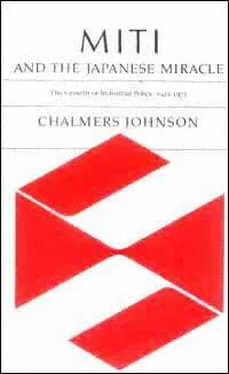Chalmers Johnson - MITI and the Japanese miracle
Здесь есть возможность читать онлайн «Chalmers Johnson - MITI and the Japanese miracle» весь текст электронной книги совершенно бесплатно (целиком полную версию без сокращений). В некоторых случаях можно слушать аудио, скачать через торрент в формате fb2 и присутствует краткое содержание. Год выпуска: 2007, Издательство: Stanford University Press, Жанр: Старинная литература, на английском языке. Описание произведения, (предисловие) а так же отзывы посетителей доступны на портале библиотеки ЛибКат.
- Название:MITI and the Japanese miracle
- Автор:
- Издательство:Stanford University Press
- Жанр:
- Год:2007
- ISBN:нет данных
- Рейтинг книги:3 / 5. Голосов: 1
-
Избранное:Добавить в избранное
- Отзывы:
-
Ваша оценка:
- 60
- 1
- 2
- 3
- 4
- 5
MITI and the Japanese miracle: краткое содержание, описание и аннотация
Предлагаем к чтению аннотацию, описание, краткое содержание или предисловие (зависит от того, что написал сам автор книги «MITI and the Japanese miracle»). Если вы не нашли необходимую информацию о книге — напишите в комментариях, мы постараемся отыскать её.
MITI and the Japanese miracle — читать онлайн бесплатно полную книгу (весь текст) целиком
Ниже представлен текст книги, разбитый по страницам. Система сохранения места последней прочитанной страницы, позволяет с удобством читать онлайн бесплатно книгу «MITI and the Japanese miracle», без необходимости каждый раз заново искать на чём Вы остановились. Поставьте закладку, и сможете в любой момент перейти на страницу, на которой закончили чтение.
Интервал:
Закладка:
62
Both of these documents were upgraded versions of the Okano Plan. Finally, in December the Yoshida government fell from power, and Yoshida's rival, Hatoyama Ichiro*, became prime minister. He in turn brought Ishibashi Tanzan back into the government as minister of MITI. The ministry's days of political oblivion were over; from now on the minister of MITI would be one of the most powerful men in the governmenthis position one of the three indispensable stepping stones to the prime ministership itself (the other two are Finance and Foreign Affairs).
Hirai has testified that Ishibashi contributed the final theoretical formulation that all other planners had been missing. Ishibashi pointed out that the key to exports was, of course, the lowering of costs, and the key to that was enlarging production to effect economies of scale. But to enlarge production, Japanese manufacturers needed more customers. And where were they to be found? In the huge potential market of Japan itself. The Japanese people had suffered from economic stringency for at least two decades; they were ready to buy anything offered to them at prices they could afford. Ishibashi's idea was that MITI should promote
both
exports and domestic sales. When problems in the international balance of payments arose, the government could curtail domestic demand and promote exports; when the problems of paying for imported raw materials eased, the focus should be on enlarging sales at home. If this could be achieved, Japan's factories could keep operating throughout all phases of the business cycle. In Hirai's words, Ishibashi "combined export promotion and high-speed growth into a coherent theory."
63
These ideas were very congenial to Ikeda Hayato. As a protégé of Yoshida's, he did not receive a post in the Hatoyama cabinets, which were transitional between the old Yoshida order and the new Liberal Democratic Party regime; the LDP was created on November 15, 1955. But in the succeeding cabinets of Ishibashi and Kishi, Ikeda served as
Page 230
minister of finance and proceeded to execute Ishibashi's ideas with a vengeance. Through his famous ¥100 billion cut in the income tax of December 1956, Ikeda put money back in the hands of consumers and industrialists as it had never been done before and began the positive stimulation of a domestic market fully half the size of that of the United States. As one contemporary Japanese analyst has put it, "the only industries in which we have seen export increases induce a production incrementinstead of the other way roundare transistor radios and perhaps cameras. We do not regard these industries as very soundly based because demand for them, especially transistors, may be saturated too soon. Export increases of all our other products have been induced mainly by expansion for the domestic market."
64
Thus it was thanks to Ishibashi and Ikeda that the high-growth system, fed by both a domestic "consumer revolution" and a new apparatus for export promotion, was finally underway.
MITI's policy statement of September 1954 led to several new institutions on the export promotion front. One was the Supreme Export Council (Saiko* Yushutsu Kaigi), composed of the prime minister; the ministers of MITI, finance, and agriculture; the governor of the Bank of Japan; the president of the Export-Import Bank; and several business leaders. Its highly public function was to set export targets for the coming year and to publicize at the highest level of government the need to promote exports by all possible means. This cabinet-level council did not, of course, make its own calculations of targets. Instead, it assigned this task to the new Economic Planning Agency (a renamed and reorganized Economic Deliberation Agency). The chief task of the EPA was the writing of "plans" that would indicate to government and business alike the goals that the nation should be striving to achieve during a given term. Needless to say, the new EPA remained as bound to MITI as its predecessors had been, although during the 1960's it attempted (unsuccessfully) to assert some independence from its powerful patron. Table 17 summarizes the EPA's first three long-range plans for the economy as a whole.
65
Another new institution was the Japan External Trade Organization (JETRO), an international commercial intelligence service set up to overcome the problem of what Hirai called "blind trade." By "blind trade" he and others meant that during the mid-1950's Japanese manufacturers were operating without detailed information on what they should be producing for various foreign markets. They also lacked agents abroad to help them keep close tabs on changes in tariff rates and specifications for products, as well as to assist in publicizing and marketing new Japanese products. JETRO was set up to do these
Page 231
TABLE
17
Plans of the Economic Planning Agency, 19551960
Item
I
Five-year plan for economic independence
II
New long-
term economic plan
III
National income-
doubling plan
Date of plan
12/1955
12/1957
12/1960
Cabinet
Hatoyama
Kishi
Ikeda
Plan period
195660
195862
196170
Planned growth rate
5.0%
6.5%

7.2%
Realized growth rate
9.1%
10.1%

10.4%
a
a
Rate for 196167.
things. By 1975 it operated some 24 trade centers and 54 reporting offices in 55 different countries.
During the 1950's there were actually three JETROs. The first was set up in 1951 in Osaka on the initiative of the mayor, Akama Bunzo * (an old MCI cadre, 192547), and Sugi Michisuke, chairman of the Osaka Chamber of Commerce and Industry. Kansai industrialists and the individual prefectures put up the money for this early organization, and MITI merely approved its activities. In 1954 MITI took it over, provided more national funds for it, and greatly expanded its operations. Finally, in 1958, in recognition of the fact that national funding now heavily outweighed that of the prefectures and that MITI wanted to bring it more securely under the ministry's control, JETRO was transformed into a public corporation with all of its capital coming from the central government (Japan External Trade Organization Law, number 95, of April 26, 1958). From 1951 on MITI also began providing key executive personnel for JETRO, notably its managing director (from 1951 to 1954 he was Okabe Kunio, the recently retired director of MITI's Trade Promotion Bureau; and from 1954 to 1965, Nagamura Teiichi, who had ended his MITI career as vice-minister of the EDA). Virtually all of JETRO's overseas personnel are MITI transferees.
66
Except during its earliest days, when it was the brainchild of Osaka business leaders, JETRO has always been an operating arm of MITI. However, its post-1958 legal status as a public corporation rather than as an agency of the government has sometimes gotten it into trouble in the United States. During the late 1950's JETRO set up in Washington an organization wholly staffed by Americans called the United StatesJapan Trade Council but failed to register it under the Foreign Agents Registration Act of 1938. As a result of this oversight, in 1976
Page 232
the U.S. Department of Justice sued the Trade Council for civil fraud, charging that 90 percent of its funds actually came from MITI via the New York office of JETRO. The Council settled out of court. It also agreed to file as a foreign agent and to identify its publications as coming from Japanese government sources. The issue in this case was not JETRO's lobbying efforts on behalf of Japanese interests but possible American confusion over just whom, exactly, JETRO represented.
Читать дальшеИнтервал:
Закладка:
Похожие книги на «MITI and the Japanese miracle»
Представляем Вашему вниманию похожие книги на «MITI and the Japanese miracle» списком для выбора. Мы отобрали схожую по названию и смыслу литературу в надежде предоставить читателям больше вариантов отыскать новые, интересные, ещё непрочитанные произведения.
Обсуждение, отзывы о книге «MITI and the Japanese miracle» и просто собственные мнения читателей. Оставьте ваши комментарии, напишите, что Вы думаете о произведении, его смысле или главных героях. Укажите что конкретно понравилось, а что нет, и почему Вы так считаете.












